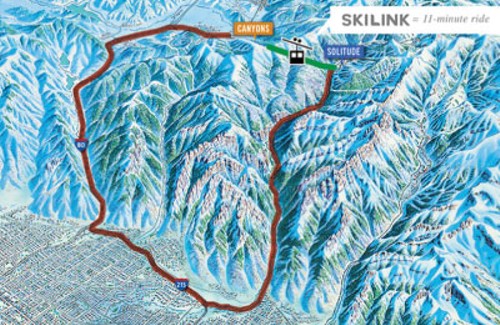You might call him Mr. Outdoors.
Among those who elevated Utah’s reputation as a mountain playground in the mid-1960s, Ted Wilson was famous for pioneering climbing routes in Little Cottonwood Canyon and scouting ski runs in hidden backcountry bowls. Over the next three decades, he’d rise from a park ranger and a high school economics teacher to popular politician, elected three times as the Democratic mayor of Salt Lake City from 1976 to 1985.
As mayor, he worked to create more Wasatch wilderness land, protect the city’s watershed and oppose developers dreaming of canyon subdivisions. After leaving politics in the late 1980s, he wrote books and articles about the mountains he loved and mentored generations of aspiring politicians as an adjunct professor at the University of Utah. He guided local environmental nonprofits, ran the Utah Rivers Council and even advised the governor as his environmental “czar.”
And then, at age 72, when most people seek a quiet retirement, he jumped feet-first into the biggest—and perhaps the most defining—political skirmish of his career.
The Ted Wilson of today is sipping coffee outside a cafe not far from his Sugar House home. He’s broad-shouldered and athletic from decades of skiing and mountaineering. Though a grandfather 13 times over, he arrived on a low-slung Suzuki motorcycle, setting his maroon helmet on an empty chair. For weeks, he resisted meeting to discuss his latest environmental cause, but today he’s talking openly about it.
“If I had to do it all over again, I might go back and say, ‘Wait a minute, I don’t want to drag my butt into this one,’ ” Wilson admits. But now his butt is firmly attached to SkiLink, the proposed gondola route that would connect the Canyons and Solitude resorts by transporting skiers over the Wasatch ridgeline that divides Salt Lake and Summit counties. If built, it would be the first gondola in the United States to join two separately owned resorts and also create the largest skiable terrain under one ticket. It would also be the first in a series of “interconnects” long desired by Wasatch resorts to create a European-style, multimountain ski experience.
Read City Weekly's SkiLink FAQ here
Wilson lobbies for SkiLink as the director of governmental affairs for Talisker Mountain Inc., the private real-estate company that owns Canyons Resort. Talisker is ready to build the $10 million project, except for one obstacle—it doesn’t have access to the strip of land in Big Cottonwood Canyon where the gondola would descend to Solitude. That land is owned by the U.S. Forest Service (USFS), is considered sensitive watershed by Salt Lake City and has been proposed as new wilderness. Facing these obstacles, Talisker decided to hire Ted Wilson to smooth the way with the environmental community so the company could purchase that land.
Counting Cars
In summer 2011, Wilson was working as an environmental adviser to Utah Gov. Gary Herbert when Talisker executives first approached him about SkiLink. “I have to confess that my gut reaction would probably to be against it, because my background is in that groove,” he says. Wilson said he changed his mind after meeting with Talisker owner Jack Bistricer, and Mike Goar, the managing director of Canyons. After listening to their pitches and reading their reports, he found the concept convincing—especially as it related to transportation. “I started to think more broadly and saw [the project] not as expanding resorts, but as a part of a complete transportation system related to getting cars out of the canyons,” he says.
While Talisker touts a $50 million economic impact and 500 new jobs as benefits of SkiLink, Wilson is focused on eliminating cars. Going back to his years as mayor, he believes poor transportation planning has intensified problems like air quality and over-development in the valley. Those problems are compounded in the canyons, he says, where slow-moving traffic and topography encourage pollution. More than ever, he believes radical solutions are needed. SkiLink, he says, can be the vanguard of multiple mountain cable-ways (gondolas) that would allow skiers to park their cars outside the canyons and never touch a gas pedal during a day of multi-resort skiing.
To support his vision, Wilson cites a Talisker-commissioned study from 2010 that claims 4,000 cars enter Big Cottonwood Canyon on an average day. If SkiLink is built, the study predicts, traffic volume in the canyon would drop by up to 300 cars a day—reducing one-way traffic at peak times by 10 percent and eliminating 18,000 vehicles each year.
“I’ve always been sort of opposed to cable-ways, mainly because visually, they are not the best thing around,” Wilson says. “But would you rather see four people in a ski lift going over the ridge, or would you rather see four people in a belching car driving up the canyon?”
Goar says Talisker contacted Wilson because of his lifelong involvement in the Wasatch backcountry as an activist, skier, climber and politician.
“It was very helpful to get Ted’s perspective on the issues that would surround a project of this type,” Goar says, sitting in his office at the base of the Canyons ski slopes just outside of Park City. “Ted is a supporter of tourism, and he is a supporter of the environment. And he is certainly a supporter of finding ways that those two can exist hand in hand.” But Goar didn’t hire Wilson to be a technical adviser. He also wanted a vocal advocate. Goar realized that pitching a controversial project like SkiLink to the Wasatch outdoor community would not be easy. He hoped that Wilson’s decades-long environmental record and connections could help.
Wilson also foresaw the challenges—and the personal risk—in taking the job. “I had to ask myself—why would I go out on a limb for SkiLink?” But the more he considered the transportation problems facing the Cottonwood canyons, the more he embraced a gondola as the right solution. Wilson said he evaluated other transportation solutions like additional road lanes, light rail or more UTA buses, but that he dismissed each of them as either too expensive or too impractical—or both.
“The public wouldn’t be able to afford a rail transit system in [Big Cottonwood] canyon. It’s too long, and serpentine,” he says. “And the problem with buses is that they are a hassle for people to use. The only way to do it would be to shut down the canyons to cars and force people to [use] buses. And then they’d probably lose a lot of skiers.”
Wilson says he kept returning to the idea that every person riding SkiLink represented a person who wasn’t in a car, and that the cost of the gondola would be borne by the ski industry—not public dollars.
“Suddenly, I thought that somebody has to lead this parade. Somebody has to get into the controversy. Somebody has to break down the barriers.”
There is passion in his voice as he speaks, but also the insight of an experienced politician. He had already explained that many of his pro-environment stands as mayor in the 1970s and ’80s—like opposing new freeways and power plants and expanding wilderness—went against Utah’s political grain. Critics bashed him on those issues, he says, but he didn’t get discouraged. “I find controversy is often very redeeming. It’s what forces people eventually to get together. And,” he adds, “I’m a kind of a feisty little guy underneath it all.”
Because SkiLink could fundamentally improve the way Wasatch residents access their mountains, Wilson decided in July 2011 to accept the lobbying job at Talisker. He realized the move would surprise and alarm people who knew about SkiLink, but he figured he could handle any backlash—and maybe even win them over. “I don’t mind taking on people if I think what I’m doing is progressive and good, and I do,” he says. But then he smiles and adds, “And I may be wrong.”
“They All Scowled at Me”
A month after joining Talisker, Wilson made his first effort to sell SkiLink to his friends in the recreation and environmental communities. And he did it the way any skier would—by offering free food and drinks.
“I invited a group of about 20 backcountry skiers to my house. I served them beer and pizza, and we sat around, and I tried to explain why I am doing this,” he says. “And they all scowled at me.”
Thinking back, Wilson realizes that he should have approached these individuals one on one. “It’s hard to be persuasive in groups when people come in with a mindset that is against you from the beginning,” he says. Wilson also recalls that several people left the meeting and immediately wrote blog posts about SkiLink that accused the former mayor of turning his back on the outdoor community.
Carl Fisher remembers that gathering at Wilson’s house. Fisher is the 31-year-old executive director of Save Our Canyons (SOC), the organization behind the thousands of bright-red “Stop SkiLink” yard signs that dot the valley. He agreed to talk about SkiLink at his new office at Artspace Commons on 400 West. Like Wilson, Fisher is a Wasatch Front native, a graduate of the University of Utah and an accomplished backcountry skier and climber. During college, Fisher parked cars at Snowbird resort but says he can’t afford to ski there now.
More by Jason Stevenson
-
The Battle for Ballpark
Ten Salt Lakers share their hopes and fears for a neighborhood in distress.
- Oct 12, 2022
-
Street Fight
Everyone in SLC says they want more affordable housing—until the city plans to put it near them.
- Jul 6, 2022
-
Your Guide to Get Outside Now
If Utah's mountains and deserts are calling, a new book from a Utah author tells you how to answer.
- Jul 29, 2020
- More »
Latest in Cover Story
Readers also liked…
-
Forget the family pedigree—Robert F. Kennedy Jr should not be the next president of the United States
Trojan Horse
- Jun 21, 2023
-
Women decry harassment and toxic culture at St. George auto dealership
Men at Work
- Oct 11, 2023







